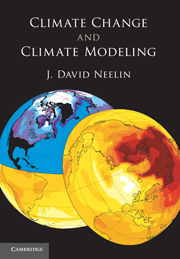Book contents
- Frontmatter
- Contents
- Preface
- 1 Overview of climate variability and climate science
- 2 Basics of global climate
- 3 Physical processes in the climate system
- 4 El Niño and year-to-year climate prediction
- 5 Climate models
- 6 The greenhouse effect and climate feedbacks
- 7 Climate model scenarios for global warming
- Glossary
- References
- Index
6 - The greenhouse effect and climate feedbacks
Published online by Cambridge University Press: 05 June 2012
- Frontmatter
- Contents
- Preface
- 1 Overview of climate variability and climate science
- 2 Basics of global climate
- 3 Physical processes in the climate system
- 4 El Niño and year-to-year climate prediction
- 5 Climate models
- 6 The greenhouse effect and climate feedbacks
- 7 Climate model scenarios for global warming
- Glossary
- References
- Index
Summary
The greenhouse effect in Earth's current climate
Global energy balance
Recall the global energy balance (Figure 2.8) from Chapter 2. Here let us review it with an eye to creating a very simple globally averaged energy balance model that may then be used to understand the results from more complex climate models.
Recall also that the upgoing energy flux leaving the surface is actually greater than the net energy from the Sun arriving at the surface because the atmosphere traps most of the upgoing energy and re-radiates part of it back downward. This is the greenhouse effect, as seen in Earth's current climate, discussed in Chapter 2. We begin by examining this climatological greenhouse effect in more detail, before going on to examine impacts of changes to the greenhouse effect.
In Figure 6.1, essential aspects of the energy budget diagram are repeated using the format and notation that will be used for the global-average energy balance model. The energy input by solar energy of 342W m−2 is immediately reduced by 31% (107 W m−2) reflected back to space, and so a net solar flux of S = 235 W m−2 enters the climate system. About 20% (67 W m−2) is absorbed in the atmosphere but the rest is absorbed at the surface for a net solar input at the surface of 168 W m−2. Considering the surface energy budget, although the solar input is the driver of the system, the largest individual terms are the infrared radiation (IR) terms.
- Type
- Chapter
- Information
- Climate Change and Climate Modeling , pp. 193 - 220Publisher: Cambridge University PressPrint publication year: 2010



